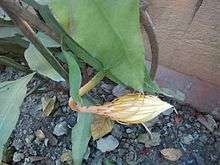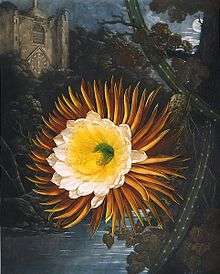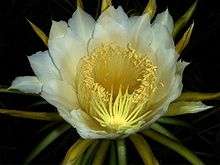Night-blooming cereus
Night-blooming cereus is the common name referring to a large number of flowering ceroid cacti that bloom at night. The flowers are short lived, and some of these species, such as Selenicereus grandiflorus, bloom only once a year, for a single night.[1] Other names for one or more cacti with this habit are princess of the night, Honolulu queen (for Hylocereus undatus), Christ in the Manger, Dama de Noche and queen of the night (which is also used for an unrelated plant species).
Genera and species

While many cacti referred to as night-blooming cereus belong to the tribe Cereeae, other night-blooming cacti in the subfamily Cactoideae may also be called night-blooming cereus. Cacti which may be called by this name include:
- Cereus
- Echinopsis (usually Echinopsis pachanoi, San Pedro cactus)
- Epiphyllum (usually Epiphyllum oxypetalum, gooseneck cactus; grown as an indoor houseplant throughout the world, and the most popular cultivated night-blooming cereus)
- Harrisia
- Hylocereus (of which Hylocereus undatus is the most frequently cultivated outdoors, and is the main source of the commercial fruit crop, dragonfruit)
- Monvillea
- Nyctocereus (usually Nyctocereus serpentinus)
- Peniocereus (Peniocereus greggii, the best known, is strictly a desert plant which grows from an underground tuber and is infrequently cultivated)
- Selenicereus (usually Selenicereus grandiflorus)
- Trichocereus
Description


Regardless of genus or species, night-blooming cereus flowers are almost always white or very pale shades of other colors, often large, and frequently fragrant. Most of the flowers open after nightfall, and by dawn, most are in the process of wilting. Plants in the same geographical area tend to bloom on the same night. Also for healthy plants there can sometimes be as many as three separate blooming events spread out over the warmest months. The plants that bear such flowers can be tall, columnar, and sometimes extremely large and tree-like, but more frequently are thin-stemmed climbers. While some night-blooming cereus are grown indoors in homes or greenhouses in colder climates, most of these plants are too large or ungainly for this treatment, and are only found outdoors in tropical areas.
Cultivation and uses
Some night-blooming cereus plants produce fruits which are large enough for people to consume. These include some of the members of the genus Cereus, but most commonly the fruit of the Hylocereus. Hylocereus fruit have the advantage of lacking exterior spines, in contrast to the fruit of cacti such as the Selenicereus fruit, being brightly colored, and having a pleasant taste. Since the late 1990s, Hylocereus fruit have been commercially grown and sold in tropical locations like Australia, the Philippines, Vietnam, Taiwan, and Hawaii.
In culture
- In the 18th century, Dr. Robert John Thornton commissioned the creation of lavishly illustrated portfolio of flora called "Temple of Flora". Plate #14 is of a "Night Blowing Cereus"[sic] (Missouri Botanical Garden Library).[2]
- In Hawaii, night-blooming cereus crown the lava rocks [3] that border Punahou School.[4] They are so associated with the school that their Hawaiian name is panini o kapunahou.
In literature
Alphabetical, by author's last name:
- A night-blooming cereus was also featured in Jacqueline Carey's Kushiel's Legacy book series as the name of one of the Thirteen Houses of the Court of Night-Blooming Flowers.
- Dorothy Gilman's character Mrs. Emily Pollifax grows a night-blooming cereus for her garden club in "The Elusive Mrs. Pollifax."
- The Night-Blooming Cereus is a poem as well as a volume of poetry by Robert Hayden.
- The Night-Blooming Cereus is a 1986 novel by Joan Hess under the name Joan Hadley.
- In Barbara Kingsolver's book The Bean Trees one of the main characters' neighbors owns a night-blooming cereus.
- In Bride of the Water God by Yun Mi-kyung, a night-blooming cereus is referred to as the "Loneliness of the Night" and refers most specifically to Epiphyllum oxypetalum. The flowers are described as being paired, so if one flower is plucked, another flower will die somewhere else. Therefore, they are also given the nickname "short-lived love".
- Shani Mootoo's novel refers to the flower in the title: Cereus Blooms at Night.
- A night-blooming cereus was featured in Jerry Spinelli's 2007 novel, "Love, Stargirl."
- John Wesley, "John Wesley's Journal", Mon. 24 July 1780, describes the blooming and fading of the "Nightly Cereus" which had a 125mm dia. white centre, and 225mm dia. "yellow ray" petals.
- In her book The Warmth of Other Suns author Isabel Wilkerson recounts her mother's memories of her grandmother's night-blooming cereus and the yearly neighborhood ritual of watching it "decide to undrape its petals".
- In the 2016 novel "The Great Stone Robbery," the author's dedication, to Jan Marie Richards, reads: "a moonflower's blush / more beautiful than anything / except maybe laughter."
See also
References
- ↑ Hecht, Hans (1997). Cacti & Succulents. Sterling Pub. Co. p. 76. ISBN 978-0-8069-0549-5.
- ↑
- ↑ http://punahou74.wordpress.com/2010/07/17/its-summer-and-punahous-night-blooming-cereus-are-blooming/
- ↑ http://www.punahou.edu
